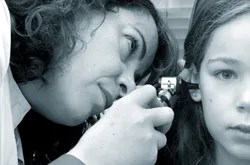My child seems exceptionally prone to ear infections during the summer. Why is this, and is there anything I can do to prevent it?

During the dog days of summer, the rise in temperature outside can be directly proportional to time spent at the neighborhood pool. Unfortunately for kids, this often means the painful occurrence and recurrence of ear infections.
Ear infections, also called otitis media, are caused when fluid gets trapped in the middle ear, where sound is transmitted from the eardrum to the part of the ear that processes sound. The trapped fluid provides an ideal environment for viral or bacterial infections to take root. As the body tries to fight the infection, the amount of fluid in the middle ear increases, which can temporarily impair hearing and put painful pressure on the eardrum.
Because of the shape of the middle ear, young children are more susceptible to infection than adults or teenagers. In fact, ear infections are so common that 75 percent of children will experience an ear infection before they are 3 years old, and some estimates put the annual cost of ear infections in the U.S. in the billions. It’s important to treat ear infections, as the associated temporary hearing loss may impair language-development skills in young children.
Unfortunately there’s not much one can do to prevent ear infections, other than keeping children’s immune systems as strong as possible. Children who seem especially prone to ear infections should therefore be kept away from sick playmates and tobacco smokers. Bottle-fed infants who feed while lying down also appear to develop these infections more frequently than breast-fed babies.
Treatment consists of antibiotics to fight the infection, and your child’s doctor may also recommend a pain reliever. Make sure the child takes all antibiotics prescribed, or the infection may recur. In cases of persistent fluid, your child’s doctor may suggest a surgical process called myringotomy, where “tubes” are inserted in the eardrum to keep the middle ear ventilated and in equal pressure with the environment.
Because many children who develop infections are too young to tell someone what’s bothering them, keep an eye out for these symptoms:
—Fluid draining from the ear
—Tugging or pulling at one or both ears
—Fever
—Signs of hearing difficulty, such as unresponsiveness to quiet sounds, or sitting close to the television.
Pramod Narula, M.D., is chairman of pediatrics at New York Methodist Hospital, Brooklyn.





















